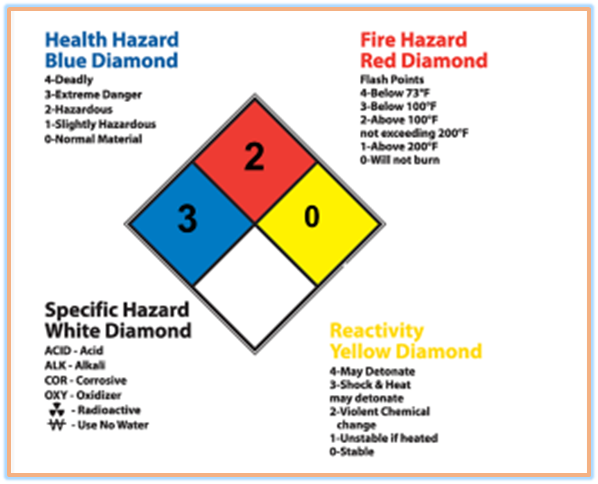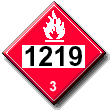This Glossary contains a list of abbreviations, acronyms, and definitions of terms.
Computer-Aided Management of Emergency Operations (CAMEO).
CAMEO is a system of software applications used to plan for and respond to chemical emergencies. Developed by EPA and the National Oceanic and Atmospheric Administration (NOAA) to assist front-line chemical emergency planners and responders, CAMEO can access, store, and evaluate information critical for developing emergency plans. For additional information, please visit EPA website at https://www.epa.gov/cameo.
Chemical Abstracts Service (CAS) Number.
The CAS number, in the format xxx-xx-x, is unique for each chemical and allows efficient searching on computerized data bases (https://commonchemistry.cas.org). Chemical Abstracts Service, a division of the American Chemical Society, assigns these identifiers to every chemical that has been described in the literature. The intention is to make database searches more convenient, as chemicals often have many names. Almost all molecule databases today allow searching by CAS number.
CHRIS Data.
The Chemical Hazards Response Information System (CHRIS) is designed to provide information needed for decision-making by responsible U.S. Coast Guard personnel during emergencies that occur during the water transport of hazardous chemicals. CHRIS also provides much information that can be used by the Coast Guard in its efforts to achieve better safety procedures and to prevent accidents. For detailed information, please click here.
Dun and Bradstreet (D&B).
The D&B DUNS Number (https://www.dnb.com) is a unique nine-digit identification sequence, which provides a unique identifier of single business entities, while linking corporate family structures together.
Emergency Planning and Community Right-to-Know Act (EPCRA)
The Emergency Planning and Community Right-to-Know Act (EPCRA) of 1986 was created to help communities plan for chemical emergencies. It also requires industry to report on the storage, use and releases of hazardous substances to federal, state, and local governments. EPCRA requires state and local governments, and Indian tribes to use this information to prepare for and protect their communities from potential risks. For additional information, please visit EPA website at https://www.epa.gov/epcra.
Extremely Hazardous Substances (EHSs).
EHSs are substances listed on the EPA's Consolidated List of Lists (https://www.epa.gov/epcra/consolidated-list-lists). These substances in quantities at or above the Threshold Planning Quantity (TPQ) require certain emergency planning activities to be conducted.
Emergency Response Guidebook (ERG).
The Emergency Response Guidebook (ERG) was developed jointly by the U.S. Department of Transportation, Transport Canada, and the Secretariat of Communications and Transportation of Mexico (SCT) for use by firefighters, police, and other emergency services personnel who may be the first to arrive at the scene of a transportation incident involving a hazardous material. It is primarily a guide to aid first responders in (1) quickly identifying the specific or generic classification of the material(s) involved in the incident, and (2) protecting themselves and the general public during this initial response phase of the incident. The ERG is updated every three to four years to accommodate new products and technology. The current version in use is ERG 2020 (https://www.phmsa.dot.gov/hazmat/erg/emergency-response-guidebook-erg).
North American Industry Classification System (NAICS) Code.
The North American Industry Classification System (NAICS) is the standard used by Federal statistical agencies in classifying business establishments for the purpose of collecting, analyzing, and publishing statistical data related to the U.S. business economy. NAICS was developed under the auspices of the Office of Management and Budget (OMB), and adopted in 1997 to replace the Standard Industrial Classification (SIC) system. For detailed information about the latest version of NAICS code, please visit U.S. Census Bureau website at https://www.census.gov/naics/.
NFPA Code.
The National Fire Protection Association (NFPA) publishes more than 300 consensus codes and standards intended to minimize the possibility and effects of fire and other risks (https://www.nfpa.org).
The most significant is the NFPA 704 Standard System for the Identification of the Hazards of Materials for Emergency Response (commonly referred to as the "NFPA hazard diamond"). These diamond shaped symbols are placed on containers of chemicals or materials to identify the degree of hazard associated with the chemical or material. The diagram identifies three color-coded categories of hazard for each material. Each category is divided in levels of hazard potential with increasing numbers indicating increasing hazards. The abbreviated degrees of hazard in each of these categories are given as follows:

Risk Management Plan (RMP).
Under the authority of section 112(r) of the 1990 Clean Air Act, the Chemical Accident Prevention Provisions require facilities that produce, handle, process, distribute, or store certain chemicals to develop a Risk Management Program, prepare a Risk Management Plan (RMP), and submit the RMP to EPA. EPA has developed a software for RMP submission called RMP*Submit. The RMP plans must be revised and resubmitted to EPA every five years. For additional information, please visit EPA website at https://www.epa.gov/rmp.
Safety Data Sheet (SDS).
The Hazard Communication Standard (HCS) requires chemical manufacturers, distributors, or importers to provide Safety Data Sheets (SDSs) (formerly known as Material Safety Data Sheets or MSDSs) to communicate the hazards of hazardous chemical products (https://www.osha.gov/sites/default/files/publications/OSHA3514.pdf). The SDSs (https://www.osha.gov/sites/default/files/publications/OSHA3493QuickCardSafetyDataSheet.pdf) must include the section numbers, the headings, and associated information under the headings below:
Tier2 Submit Software.
Section 312(a) of the Emergency Planning and Community Right-to-Know Act (EPCRA) requires the owner or operator of facilities subject to Section 311 of EPCRA to submit an emergency and hazardous chemical inventory form by March 1 of each calendar year to the State Emergency Response Commission (SERC), the Local Emergency Planning Committee (LEPC), and the local fire department. Facilities provide either a Tier I or Tier II form. Most States require the Tier II form. Some states have specific requirements in addition to the federal Tier II requirements. For additional information, please visit EPA website at https://www.epa.gov/epcra/tier2-submit-software.
Toxics Release Inventory (TRI).
The Toxics Release Inventory (TRI) is a resource for learning about toxic chemical releases and pollution prevention activities reported by industrial and federal facilities. TRI data support informed decision-making by communities, government agencies, companies, and others. Section 313 of the Emergency Planning and Community Right-to-Know Act (EPCRA) created the TRI. For additional information, please visit EPA website at https://www.epa.gov/toxics-release-inventory-tri-program.
UN/NA Number.
United Nations/ North American (UN/NA) are required for the shipment of hazardous materials. UN/NA numbers are not required elements by Occupational Safety and Health Administration (OSHA) on an Safety Data Sheet (SDS), although many sheets have them to simplify shipping requirements.

The University of Texas at Dallas (UT Dallas).
UT Dallas is a public research university in Richardson, Texas. It is one of the largest public universities in the Dallas area and the northernmost institution of the University of Texas system.